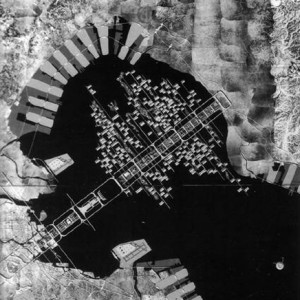Passing through the Post-war reconstruction and the Great earthquake, perspective of Japanese creators has been changed in terms of scale.

Figure 1 Tokyo Bay Plan by Kenzo Tange
Scale A. Grand Urban Visions of Metabolism (Seamless connection from human to city)
After the War, numbers of Metabolists in Japan came up with visions of reconstruction. Their initial concepts and master plans were big enough to cover the entire construction of new cities. Even though the realization has been done in relatively small sizes, the projects and plans had strong future implications. For instance, Kisho Kurokawa’s Nakagin Capsule Tower in Tokyo is representing a new form of architecture as in urban scale. From a construction process to final output and afterwards plan, every step was experimental and practical enough to inspire and to change the following massive urban constructions.

Figure 2. Small Tokyo: edited by Darko Radović and Davisi Boontharm, was published by Flick Studio and IKI
Scale B. Small and Fragmentized(Characterization of New smallness)
After Japan had quick recovered economy and had built the substantial parts of the cities, the scale of planners had been changed as well. Stabilized society made architects and creators to think more about everyday lives rather than grand infrastructures of cites. The scale of creations has been gradually decreased. Small and fragmentized units of designs, which are much more tangible for humanity, have been evolved lately. Degradation of urban development and shrinking population of Japan also helps the downsizing of objects. And, this new scale phenomenon, ’Smallness’, has been developed profoundly and has symbolized the new urban scale of metropolitan cities in Japan.
Figure 3 [ METABOLISM – The City Of The Future] exhibition] at Mori Art Museum in Roppongi
Scale C. After Earthquake
After earthquake happened, the concept of Metabolism has been arising again. This grand vision of new cities has been refocused. Since the Great Earthquake swept away the entire infrastructures of cities and following earthquake predictions are threating the existing structures, radical envisioning of new cities has been needed. And Metabolism visions are persuasive enough to inspire the new reconstructions.
However, is it an appropriate scale of idea for new cities?
Scale D. Continuous Scale
Lastly, I want to refer ‘ASADAS SCALE’, which is proposed by Asada Takashi. He worked with Kenzo Tange in the Tange Laboratory at Tokyo University. His concept of this scale is to connect every object, which is from a single atom to entire galaxies, into a single loop. After seeing the aftermath of Hiroshima Atomic Bomb, he was shocked by the fact that two single atoms could evaporate the entire city instantly. He had tried to think about the positive use of this instant continuous scale in innovative urban construction. Even though this concept is still in figurative stage, this scale could be valid in terms of reconstruction of disaster affected cities, since it is covering both small everyday lives and large urban envisioning at the same time.

